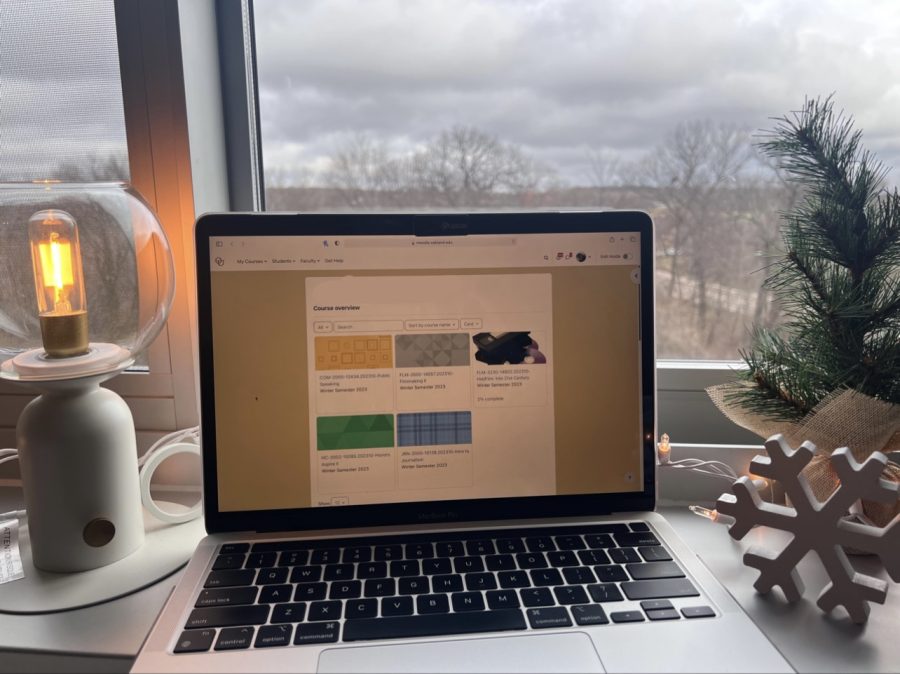Campus community reacts to new Moodle update
Students and faculty had a brand new Moodle interface staring back at them upon logging in for the first time this Winter semester.
Moodle 4.0 was released by the learning platform in April 2022 and implemented by OU in December. It introduced a new look for the platform that – according to Moodle’s website – was designed to both facilitate the prioritization and completion of coursework for students and to simplify the process of creating and editing course structure and content on the faculty side.
For students, this update includes a revamped dashboard fit with an interactive timeline and calendar housing assignment due dates, a collapsible sidebar course index, “to-do” and “mark as done,” tabs to track activity completion, and collapsible content dividers and informational resource sidebars.
As for faculty members, new features include the same collapsible content sidebars, plus the ability to restructure their course content by dragging items along the course index bar. This update also offers built-in video conferencing through BigBlueButton, which promises the same features familiar to Zoom users, plus the ability to share notes and interact on a whiteboard as a class. Additionally, Moodle 4.0 boasts advanced accessibility features, including an enhanced text editor which facilitates screen reader function and keyboard navigation.
According to Dr. Nic Bongers, an instructional designer at OU’s e-Learning and Instructional Support (e-LIS) department, these features culminate in what he calls “the best version of Moodle he’s ever seen.”
Bongers feels the new version is far more intuitive than previous installments — and plenty of faculty are in agreement.
“For the first time, I feel like I enjoy going on Moodle to post things,” Dr. Kwama Sakyi, associate professor of public health, said. “I do really like the interface. It is lively and easy to navigate. I love how you can collapse materials on weeks and content that are no longer relevant — it creates less clutter on the page.”
From an organizational perspective, Sakyi identifies both pluses and minuses to the new version of the platform. While he misses the ability to indent certain pieces of content on the course landing page, he’s a fan of the collapsibility of content offered with the new edition, allowing class participants to hide materials from previous weeks to “create less clutter on the page.”
Dr. Kenneth Mitton, associate professor of biomedical sciences, said he uses Moodle to the fullest extent in his courses – from preparing informative resources for each class day to accepting all written assignments through various file formats on the platform – and has been pleased with the way this update has facilitated his processes.
“It is easier to access the design and settings for quizzes [with the new update],” Mitton said. “In the previous version of Moodle, the setup of quiz general settings and the building of questions for the quiz were accessed from completely separate menu navigations — now they are all in one set of tabs.”
For Dr. Rebecca Mercado Jones, associate professor of communication, her strongest feelings regarding the platform’s update have little to do with the nitty gritty details and more with the timing of the changes.
“That period between December and January is not the time to change an interface – the time to change an interface is over the summer, weeks before classes have started, where professors can have some time with the interface rather than open up the Moodle page to put all their new class materials on there and say, ‘holy sh*t, there’s a new interface, and I have to teach class in five days,” Mercado Jones said.
Mercado Jones is not alone in her frustration — many student reactions to the update have echoed a similar disapproval for timing of the change.
“I don’t really like how they changed Moodle, especially during break,” accounting major Lauren Weir said, “and then we get back to a whole new semester and need to learn how to figure out everything again.”
Bongers said e-LIS initially planned to implement Moodle 4.0 in July 2022, but ultimately decided to postpone the change until just after Fall 2022 grades were due out of a desire not to “cross contaminate” the introduction of the new version with other updates being made to e-learning servers around that time. Additionally, the e-LIS department wanted to devote adequate time to the production of instructional documents and tutorial videos to accompany the eventual launch of the new version.
In the months preceding the update, Bongers said the e-LIS department called upon the e-LIS Advisory Committee (EAC), their faculty advisory board, to meet monthly for discussions about what was to come and experience the new Moodle version while it was still in its testing phase.
“We would show them the navigation, we’d ask for feedback on how it looks — in fact, the Moodle theme – how things are colored, how things look – we would bring up different options to that advisory committee and ask for feedback,” Bongers said. “So we’ve been getting feedback from faculty all along the way, before it was finally implemented.”
Bongers has also been providing workshops for faculty learning the ropes of the new Moodle version since November.
On the student end, reactions to the update are mixed — a phenomenon nursing major Jonethan James attributes to somewhat of a knee-jerk reaction to change.
“I think anything new or a thing that brings change is a little upsetting or uncomfortable, but I think with time we’ll get used to it and start to enjoy it,” James said. “I do like how they kept the main parts of Moodle — […] I don’t think it’s too far removed from the old [version], where I’m completely annoyed. I did get comfortable with the old Moodle, obviously, so this was just like a, ‘oh, why now, with just one semester left?’ thing.”







